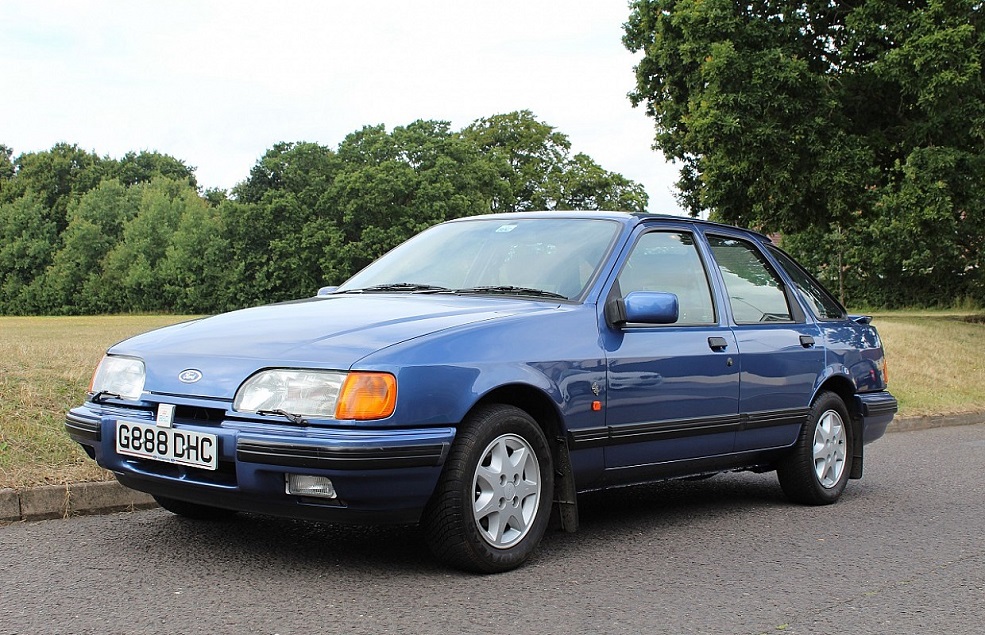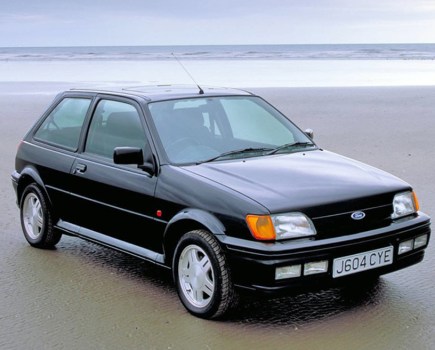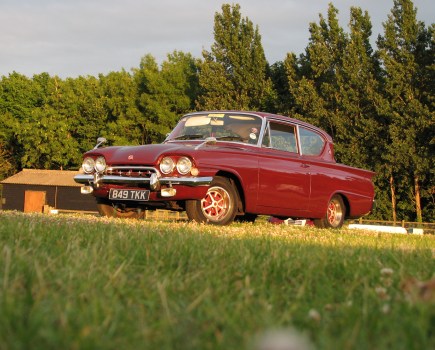Originally confined to obscure German-market saloons, the Ford Cologne V6 has powered loads of cars on both sides of the Atlantic. Here are our favourites
Words: Sam Skelton
Ford of Germany launched the Cologne V6 in 1964 – two years before the British Essex. Like the British engine it was a derivation of an existing V4, this time the one from the German Ford Taunus range. Initially a 2.0-litre, it was intended for the Taunus 20M – but by the time production ceased in 2011 the Cologne had been produced in variants spanning 1.8- to 4.0-litres in size. It had even been used early in a sports car intended to be marketed through Ford dealers in Italy. The Siva Sirio was the work of Achille Candido and used a Moretti-designed chassis with a fetching body reminiscent of the later Dino 246GTS – this styled by former Bizzarrini stylist Domenico Iseglio. Plans to build up to 800 in the first 18 months went awry when Candido’s financial backers pulled out.
The first British Ford to use the Cologne V6 was the Cortina Mk4 2.3 Ghia of 1977 – effectively a British market rebadging of the contemporary Taunus. This range topper was launched the year after Mk4 production began, catering for those who felt that the 2.0-litre Pinto was inadequate for a car with such luxury trappings. The launch of the Mk2 Granada the following year saw the Essex of the Mk1 replaced with a series of 2.3- and 2.8-litre Cologne engines, while in 1981 the 3.0-litre Capris were finally replaced by the new 2.8 Injection. By the time of the Sierra’s launch the Cologne V6 was a part of British culture – it became obvious that the 2.3 would continue in Ford’s mid-liner, and that the 2.8-litre variant would be used for the XR4i Capri replacement. Later Sierras would sprout four-wheel drive, and subsequently the 2.9-litre variant of the Cologne.
The Cologne V6 had earned itself plenty of fans in Europe and America by this point. It was the basis of the 2.6-litre engine in the Capri RS2600, as well as the standard engine across the majority of Ford of Europe’s larger offerings such as the P7 and the Mk1 Granada – which may have used the Essex in England, but continental examples came with the Cologne.
In America, it made its name in the Mercury Capri, Mercury Bobcat and Ford Pinto in 2.8-litre guise, while the later 2.9 spearheaded Ford’s attempt to inject some European flair with the Merkur brand. The Merkur Scorpio was a rebadged Granada Mk3. The Merkur XR4Ti might have looked like the British Sierra 2.8, but actually used a 2.3-litre turbocharged Pinto instead.
The Ford Ranger and Ford Explorer both used 4.0-litre derivatives of the Cologne, as did the Brazilian ARO Cross Lander 244X – an off-road vehicle which bore more than a slight resemblance to the Land Rover Series 109-inch. In some markets – chiefly America and the Antipodes – the Land Rover Discovery 3 was also available with an SOHC variant of the originally-pushrod Cologne in a 4.0-litre size. Cologne production officially ceased in 2011.
Britain’s last dalliance with the Cologne came in the form of the Mk3 Granada, and subsequent Scorpio facelift. And the best variant of the Cologne has certainly been saved until last. In 1991 Cosworth Engineering took the 2.9-litre Cologne and re-engineered the top end. It lost its pushrods in favour of twin overhead camshafts, an oil pump driveshaft in place of the original camshaft, and a long duplex timing chain. This engine, the Cosworth BOA, produced 195bhp and 275lb.ft of torque, and was used until the revision from Mk3 Granada to Scorpio in 1994. All 24v Granadas and Mk3 Scorpios were automatic from new, though many have been converted to manual. For the final Scorpios, the engine was revised into the Cosworth BOB – which featured a pair of shorter simplex timing chains with twin hydraulic tensioners, and a variable-length inlet system. This engine produced 210bhp, though was still automatic-only from new.
The Scorpio was the last rear-wheel drive large Ford; subsequent models used the Duratec V6 in front-drive transverse applications such as the Mondeo.

Ford Scorpio Cosworth 24V
The Ford Scorpio has made our list for another reason; as well as being the last UK-market saloon car to use the Cologne V6 when the FWD Duratec was already in its stride, it’s also had a bit of an unfair image problem. It remains the one classic Ford for which prices have stayed relatively sane, owing in no small part to its looks.
Yes, it’s ‘transatlantic’, and that doesn’t always work here. But big Fords have always been so – from the ‘Five Star’ Consul and Zephyr Six of 1950, it’s been impossible to name a big Ford which hasn’t chimed with American styling trends. The Scorpio carried on that tradition to an era where American design was lacking. And on the top ones behind that face sat a 24v Cosworth-tuned unit, married to a chassis every bit the equal of the contemporary BMW 5 Series.
It also retains the simplicity of its forebear in terms of maintenance. So what if it looks surprised? You’ll be equally surprised when you drive one and find one of Britain’s best kept performance saloon secrets.

Reliant Scimitar
It seems surprising that it took the world so long to cotton on to the sports estate formula. Based on a concept car used by Prince Philip, Ogle’s restyle of its previous Reliant Scimitar coupe brought practicality to the world of the GT. The SE5 models all used the Essex V6, a carryover from the last of the SE4 Scimitar GT coupes – while later SE6 models used a mix of Essex and Cologne depending upon the year of the car.
Most Scimitars are automatic, and the box suits the car well, but the manual option turns the comfortable GT into a most entertaining semi sports car. GRP bodies and galvanised chassis on the later SE6b cars make them viable as classic daily drivers, too. The later SE8b convertible might offer wind in the hair but is a less practical and less appealing proposition cosmetically.
The Middlebridge cars produced during the late 1980s used the later 2.9-litre engine and electronic injection, as well as bespoke trimmings. These are well worth having, though they command a considerable price premium.

Ford Sierra XR4X4
The Audi Quattro had taken the performance car world by storm in the early 1980s. All-wheel drive linked to a powerful engine made an unstoppable combination, and anyone who was anyone wanted a slice of the action. Unfortunately, a Quattro cost the average yuppie more than a Porsche 911 when new, so was out of reach to the man on the street. Enter Ford: The Sierra XR4x4 of 1985 used a pair of Ferguson Formula viscous differentials with two thirds of the power sent to the back. The idea was to improve traction and grip, to turn what was already a formidable performance saloon into a world beater.
Initially a three-door hatch, the model expanded to include a five-door model and a Ghia-specced estate. Early 4x4s used the 2.8-litre Cologne V6, upgraded to the 2.9 with new electronic injection for 1989. Lesser known was the slightly lower-specified 2.9i GLS 4×4 – a wolf in sheep’s clothing, this car married the subtle looks of the GLS with the engine and drivetrain of the XR4x4 and is the rarest 4×4 derivative today.

Ford Capri 2.8 Injection
Was the Capri the car you always promised yourself? For so many in 1970s and 1980s Britain, it certainly was – and while most V6 Capris used the Essex, the one we’re concerned about is the Cologne-powered 2.8 Injection. This usurped the 3.0 models in 1981 and went like lightning if the TV campaign was anything to go by. Bodie and Doyle had stopped using Capris by then, and Del Boy was yet to drain their cred with his lime green Ghia.
While undoubtedly an old model, Capri still had clout, though its image as king of the hill was challenged by Opel’s Manta and Monza. It’s telling that when Ford felt Capri sales too low to continue, the XR4i which replaced it kept the injected Cologne at its core. Nowadays a Capri offers enthusiasts the chance to live their childhood dreams without wasting money – indeed, a good 2.8i is a significantly better bet than money in the bank.

Panther Kallista
The Panther Lima was an excellent concept, for those into that sort of thing. Take everyday mechanicals – in this case the Vauxhall slant-four – marry them to a retro body, and watch those who couldn’t wait for a Morgan queue up to buy one. But when supplies of Viva and Magnum parts became scarce, Panther turned to Ford to supply parts for the Kallista.
This car was effectively a modified and simpler Lima, with a greater profit margin and lower price to capitalise on the cessation of MG and Triumph sports cars. It was wider and longer too, with stretched doors to improve access and a fully folding hood. Many were fitted with Ford’s Pinto, but the 2.8-litre Cologne was available for those who wanted their traditional sports car to pack some poke. In 1989 the 2.8-litre was retired in favour of the new 2.9-litre unit.

Merkur Scorpio
During the 1980s, America was a golden market for European cars. For one, they were typically more efficient, and for a second there was a mystique to them which made them more desirable. Even if a Sterling 827 wasn’t a Jaguar, it came from the same place and was built by similar people. Ford, with its own European division, was in a good position. It not only had the exciting European cars but the strong US dealer network in which to sell them. Ties to the Mercury brand, Ford chose the Merkur brand as a literal German translation of Mercury.
Its second product was the Scorpio – Europe’s Ford Scorpio, complete with its 2.9 litre Cologne V6 and manual transmission as standard. Most of the Scorpios sold were automatic, however – American buyers preferred self-shifters, especially in a marketplace crowded by the Mercedes-Benz 190, Saab 9000 and Volvo 740. As a brand Merkur was a failure almost akin to Edsel – lasting just four model years before Ford pulled the cars from showrooms.

TVR Tamsin 280i
The first of the TVR Wedge models was the Tasmin, looking like a cut-price DeLorean courtesy of Oliver Winterbottom’s sharp-edged styling, the Tasmin was available with a brace of engines plucked from the Ford Granada range. Entry level was the Tasmin 200 with the Pinto under the bonnet. But most buyers chose the powerful Tasmin 280i, which would continue alongside the subsequent V8s shorn of its Tasmin nameplate. The 280i came with a choice of three bodies; coupe, 2+2 and convertible. Not only was this the first TVR to be made available as an automatic, but also the last to be sold in the United States. It was replaced for two reasons.
Firstly, new boss Peter Wheeler wanted more power – prompting fitment of the Rover V8. Secondly, Ford’s dealings with Israel had made it unpopular with certain Arab nations – and the fitment of a Rover engine suddenly opened up these markets in which TVR had been unpopular by association. As TVRs grew ever more wayward there was no position for an entry level model that didn’t sell in key markets. The 280i was dropped in 1987, four years after the launch of the smallest V8-engined model, the 350i.
Classic Ford Show 2024
The Classic Ford Show – Europe’s largest classic Ford event – will take place on Sunday, May 12 at the South Of England Showground in West Sussex.
The show is set to celebrate its 20th anniversary in style, with highlights including the Great Unveiling, a celebration of the Ford Capri at 55 years and The Top 50, a collection of the finest classic Fords in the UK and Europe. Hundreds of cars are due to be on display, a retail village will feature and weekend camping is available.
Adult tickets cost £20 (plus booking fee) in advance with a saving of up to £8 on the gate price. A Classic Ford Show guide worth £9.99 is free with each advanced ticket. Tickets for children aged 5-14 are £5, with under-5s going free






